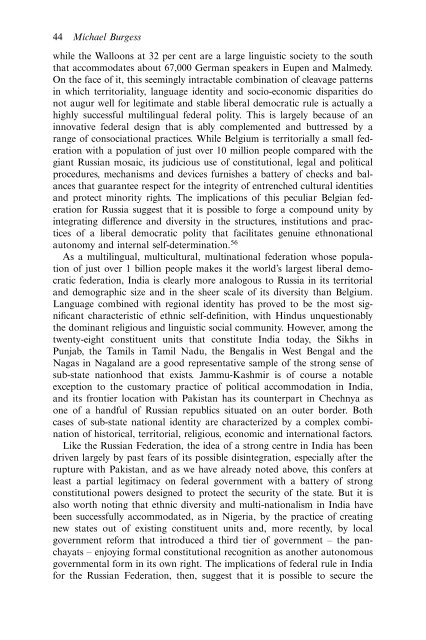Federalism and Local Politics in Russia
Federalism and Local Politics in Russia
Federalism and Local Politics in Russia
Create successful ePaper yourself
Turn your PDF publications into a flip-book with our unique Google optimized e-Paper software.
44 Michael Burgesswhile the Walloons at 32 per cent are a large l<strong>in</strong>guistic society to the souththat accommodates about 67,000 German speakers <strong>in</strong> Eupen <strong>and</strong> Malmedy.On the face of it, this seem<strong>in</strong>gly <strong>in</strong>tractable comb<strong>in</strong>ation of cleavage patterns<strong>in</strong> which territoriality, language identity <strong>and</strong> socio-economic disparities donot augur well for legitimate <strong>and</strong> stable liberal democratic rule is actually ahighly successful multil<strong>in</strong>gual federal polity. This is largely because of an<strong>in</strong>novative federal design that is ably complemented <strong>and</strong> buttressed by arange of consociational practices. While Belgium is territorially a small federationwith a population of just over 10 million people compared with thegiant <strong>Russia</strong>n mosaic, its judicious use of constitutional, legal <strong>and</strong> politicalprocedures, mechanisms <strong>and</strong> devices furnishes a battery of checks <strong>and</strong> balancesthat guarantee respect for the <strong>in</strong>tegrity of entrenched cultural identities<strong>and</strong> protect m<strong>in</strong>ority rights. The implications of this peculiar Belgian federationfor <strong>Russia</strong> suggest that it is possible to forge a compound unity by<strong>in</strong>tegrat<strong>in</strong>g difference <strong>and</strong> diversity <strong>in</strong> the structures, <strong>in</strong>stitutions <strong>and</strong> practicesof a liberal democratic polity that facilitates genu<strong>in</strong>e ethnonationalautonomy <strong>and</strong> <strong>in</strong>ternal self-determ<strong>in</strong>ation. 56As a multil<strong>in</strong>gual, multicultural, mult<strong>in</strong>ational federation whose populationof just over 1 billion people makes it the world’s largest liberal democraticfederation, India is clearly more analogous to <strong>Russia</strong> <strong>in</strong> its territorial<strong>and</strong> demographic size <strong>and</strong> <strong>in</strong> the sheer scale of its diversity than Belgium.Language comb<strong>in</strong>ed with regional identity has proved to be the most significantcharacteristic of ethnic self-def<strong>in</strong>ition, with H<strong>in</strong>dus unquestionablythe dom<strong>in</strong>ant religious <strong>and</strong> l<strong>in</strong>guistic social community. However, among thetwenty-eight constituent units that constitute India today, the Sikhs <strong>in</strong>Punjab, the Tamils <strong>in</strong> Tamil Nadu, the Bengalis <strong>in</strong> West Bengal <strong>and</strong> theNagas <strong>in</strong> Nagal<strong>and</strong> are a good representative sample of the strong sense ofsub-state nationhood that exists. Jammu-Kashmir is of course a notableexception to the customary practice of political accommodation <strong>in</strong> India,<strong>and</strong> its frontier location with Pakistan has its counterpart <strong>in</strong> Chechnya asone of a h<strong>and</strong>ful of <strong>Russia</strong>n republics situated on an outer border. Bothcases of sub-state national identity are characterized by a complex comb<strong>in</strong>ationof historical, territorial, religious, economic <strong>and</strong> <strong>in</strong>ternational factors.Like the <strong>Russia</strong>n Federation, the idea of a strong centre <strong>in</strong> India has beendriven largely by past fears of its possible dis<strong>in</strong>tegration, especially after therupture with Pakistan, <strong>and</strong> as we have already noted above, this confers atleast a partial legitimacy on federal government with a battery of strongconstitutional powers designed to protect the security of the state. But it isalso worth not<strong>in</strong>g that ethnic diversity <strong>and</strong> multi-nationalism <strong>in</strong> India havebeen successfully accommodated, as <strong>in</strong> Nigeria, by the practice of creat<strong>in</strong>gnew states out of exist<strong>in</strong>g constituent units <strong>and</strong>, more recently, by localgovernment reform that <strong>in</strong>troduced a third tier of government – the panchayats– enjoy<strong>in</strong>g formal constitutional recognition as another autonomousgovernmental form <strong>in</strong> its own right. The implications of federal rule <strong>in</strong> Indiafor the <strong>Russia</strong>n Federation, then, suggest that it is possible to secure the
















